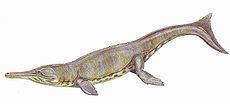Phylum Chordata Superfamily †Metriorhynchoidea Rank Family | ||
 | ||
Lower classifications | ||
Metriorhynchidae is an extinct family of specialized, aquatic metriorhynchoid crocodyliforms from the Middle Jurassic to the Early Cretaceous period (Bajocian - Valanginian stages) of Europe, North America and South America. The name Metriorhynchidae was coined by the Austrian zoologist Leopold Fitzinger in 1843. The group contains two subfamilies, the Metriorhynchinae and the Geosaurinae.
Contents
Description
Metriorhynchids are fully aquatic crocodyliforms. Their forelimbs were small and paddle-like, and unlike living crocodilians, they lost their osteoderms ("armour scutes"). Their body shape maximised hydrodynamy (swimming efficiency), as did having a shark-like tail flukes.
Metriorhynchids were the only group of archosaurs (aside from seabirds, and technically pelagic pterosaurs such as nyctosaurids) to become fully adapted to the marine realm, becoming pelagic in lifestyle. With tail flukes, reduced limb musculature, and long bones histologically comparable to other obligately aquatic animals, they were almost certainly incapable of terrestrial locomotion; combined with an unusually tall hip opening, as also seen in other obligately aquatic reptiles including the viviparous Keichousaurus, this has lent credence to the suggestion that metriorhynchids gave live birth.
The family has a wide geographic distribution, with material found in Argentina, Chile, Cuba, England, France, Germany, Italy, Mexico, Poland, Russia and Switzerland.
Classification
Phylogenetic analyses published during the 2000s cast doubt on the idea that many traditional metriorhynchid genera formed natural groups (i.e., include all descendants of a common ancestor). The traditional species of Geosaurus, Dakosaurus and Cricosaurus were found to represent unnatural groups, and the species traditionally classified in these genera were reshuffled in a study published in November 2009 by Mark T. Young and Marco Brandalise de Andrade. The monophyly of Metriorhynchus and Teleidosaurus is also unsupported, and the species of these genera are pending reclassification.
The classification presented by Young and Andrade in 2009 was approved in later studies of the Metriorhynchidae. Metriorhynchidae is a node-based taxon defined in 2009 as the least inclusive clade consisting of Metriorhynchus geoffroyii and Geosaurus giganteus. The cladogram below follows the topology from a 2011 analysis by Andrea Cau and Federico Fanti with clade names from Young et al. 2011 and reduced to genera only.
List of genera
The type genus of the family Metriorhynchidae is Metriorhynchus from the Middle to Late Jurassic. Other genera included within this family are Cricosaurus, Geosaurus, and Dakosaurus. Though once considered a metriorhynchid, Teleidosaurus has since been found to be slightly more distantly related to these animals within the superfamily Metriorhynchoidea.
Within this family, the genus Neustosaurus is considered nomen dubium ("doubtful name").
The genus Capelliniosuchus was once thought to be a metriorhynchid similar to Dakosaurus. However, Sirotti demonstrated that it is a junior synonym of Mosasaurus.
